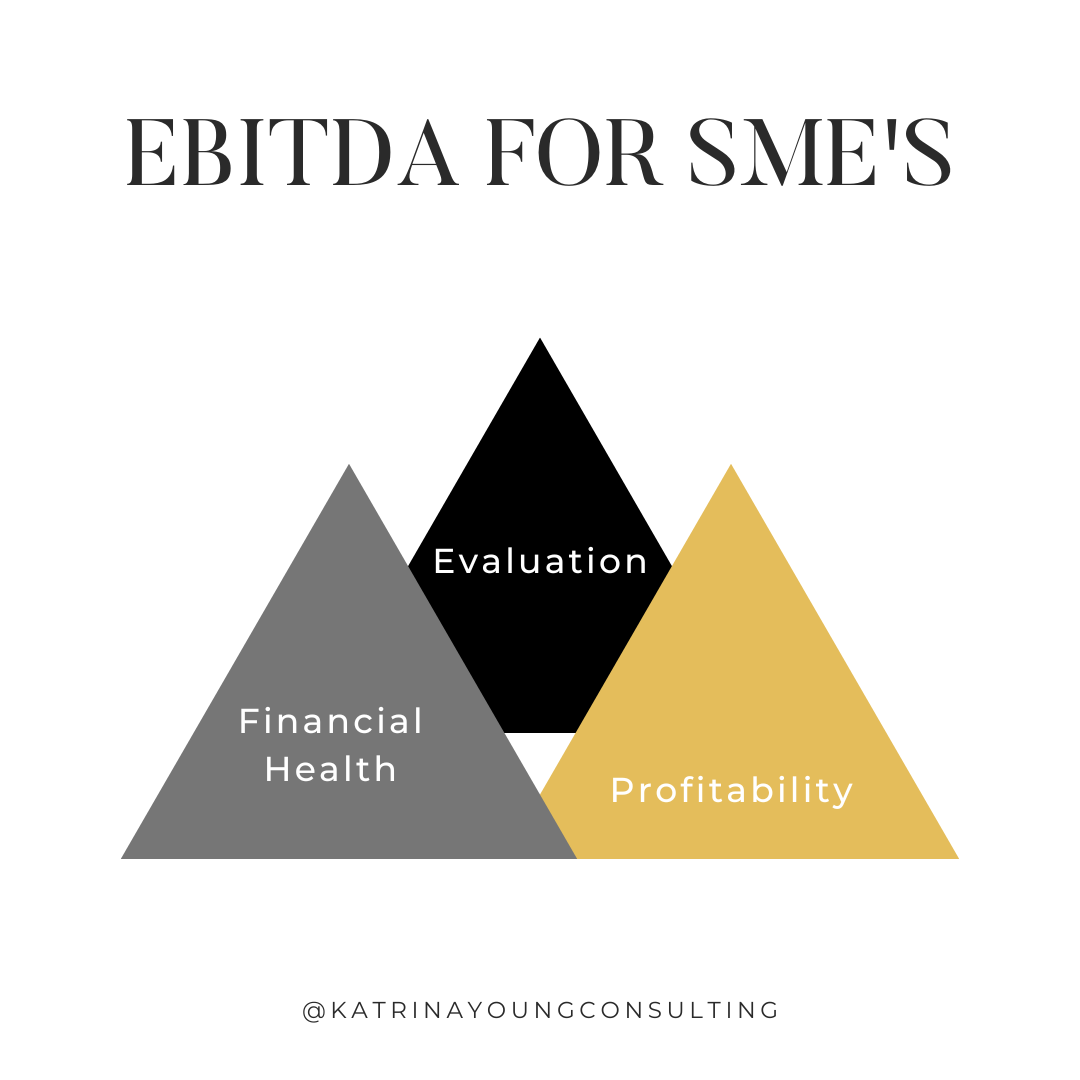EBITDA For SME's
ebitda for SME's
〰️
ebitda for SME's 〰️
As a business owner, you've probably heard the term EBITDA thrown around before. But do you really know what it means and how it can impact your SME's success? EBITDA stands for Earnings Before Interest, Taxes, Depreciation, and Amortisation, and it is a financial metric used to evaluate a company's profitability.
In blog I will share a guide, covering everything SMEs need to know about EBITDA, from what it is and how to calculate it, to why it matters and how to improve it. Before it is too late, honestly nobody explained this to me !
What is EBITDA?
EBITDA is a financial metric used to measure a business/company's profitability by subtracting operating expenses from revenue. This metric is commonly used to evaluate the financial health of a business, especially when comparing similar companies in the same industry. This can be a deciding factor as to the key
profitability
services or areas that need to cease
key drivers
highlight risks and areas of concern
EBITDA Calculation
The formula for calculating EBITDA is straightforward:
EBITDA = Revenue - Operating Expenses
Operating expenses include salaries and wages, rent, utilities, and other expenses related to the operation of the business. This calculation does not include interest, taxes, depreciation, and amortization, as they are considered non-operating expenses.
Why is EBITDA important for SMEs?
EBITDA is a valuable metric for SMEs because it provides a clearer picture of the company's profitability than net income alone. Since it excludes non-operating expenses, EBITDA provides a more accurate representation of the company's operating performance, which can be especially important for businesses with significant interest expenses, depreciation, or amortization.
Additionally, EBITDA is frequently used by investors and lenders to evaluate the company's ability to generate cash flow and repay debt. By calculating EBITDA, SMEs can assess their financial health and determine how much debt they can realistically take on.
How to improve EBITDA
Improving EBITDA can be a challenging task for SMEs, but there are several strategies that can be used to boost this important financial metric:
Reduce operating expenses: One of the most effective ways to improve EBITDA is to reduce operating expenses. This can be achieved by negotiating better deals with suppliers, cutting unnecessary costs, and increasing efficiency in operations.
Increase revenue: Another way to improve EBITDA is to increase revenue. This can be accomplished through increased sales, higher prices, or expanding into new markets.
Optimise pricing strategy: SMEs can also improve EBITDA by optimising their pricing strategy. They can increase revenue and improve profitability by identifying the optimal price point for their products or services.
Focus on high-margin products or services: SMEs can also focus on high-margin products or services to improve EBITDA. By identifying the products or services with the highest profit margins and concentrating on those, they can improve profitability and generate more cash flow.
Reduce non-operating expenses: SMEs can improve EBITDA by reducing non-operating costs. This can include refinancing debt to minimise interest expenses or selling off assets to reduce depreciation or amortisation expenses.
EBITDA is a valuable financial metric for SMEs to track, as it provides a clear picture of the company's profitability and ability to generate cash flow. By focusing on strategies to improve EBITDA, SMEs can achieve financial stability and position themselves for long-term success.
Step 1: Determine Revenue To calculate EBITDA, you first need to determine your company's revenue for the period you are analysing. This can be found on your company's income statement.
Step 2: Determine Operating Expenses Next, determine your company's operating expenses. These expenses can include things like salaries and wages, rent, utilities, and other costs associated with running your business. Operating expenses can also be found on your company's income statement.
Step 3: Add Back Depreciation and Amortization Depreciation and amortization are non-cash expenses that reduce your company's net income but do not affect cash flow. To calculate EBITDA, you need to add these expenses back to your operating income. You can find depreciation and amortisation on your company's balance sheet.
Step 4: Add Back Other Non-Operating Expenses If your company has any non-operating expenses, such as interest expenses or losses from the sale of assets, you need to add those back as well.
Step 5: Calculate EBITDA Once you have determined your company's revenue, operating expenses, and other non-operating expenses, you can calculate EBITDA by adding back depreciation, amortisation, and other non-operating expenses to your operating income.
EBITDA = Revenue - Operating Expenses + Depreciation + Amortisation + Other Non-Operating Expenses
Action Points:
Familiarise yourself with the income statement and balance sheet of your company
Identify the revenue and operating expenses for the period you want to analyse
Find the depreciation, amortisation, and other non-operating expenses on your balance sheet
Use the formula above to calculate your EBITDA
Analyse your EBITDA and use it to make strategic decisions for your business.
Looking for Business Growth solutions? Complete the contact form below to learn more about the solutions available to suit your personal needs.
EBITDA is a critical financial metric for SMEs as it provides a clear and concise snapshot of the financial health of a business, products and service.
One of the primary benefits of using EBITDA as a financial metric is that it removes the impact of certain expenses, such as interest, taxes, depreciation, and amortization. By doing so, it helps to provide a more accurate picture of a company's operating profitability and helps to facilitate more meaningful comparisons between companies.
Furthermore, EBITDA is an important metric for investors, providing insight into a company's ability to generate cash flow from its core operations. This can be particularly important for SMEs that are seeking to raise capital or attract new investors.
According to a recent report by Ernst & Young, EBITDA multiples for private businesses have been on the rise in recent years. The report notes that in 2019, the median EBITDA multiple for private businesses was 5.8x, up from 5.5x in the previous year. This indicates that investors are placing increasing importance on EBITDA as a measure of a company's financial health.
In addition, a study by the National Bureau of Economic Research found that companies with higher EBITDA margins tended to have a higher probability of survival during economic downturns. This highlights the importance of maintaining a healthy EBITDA margin for SMEs, particularly during challenging economic times.
Dont wait until its too late to understand EBITDA, it is an essential financial metric for SMEs. By using EBITDA to measure their operating profitability and cash flow generation, SMEs can better understand their financial health, attract new investors, and improve their chances of long-term success.
Action Guide for SMEs:
Calculate your EBITDA: Start by calculating your EBITDA using the formula mentioned in the blog post. This will help you to get a clear picture of your company's operating profitability.
Monitor your EBITDA: Keep a close eye on your EBITDA regularly, such as monthly or quarterly. This will help you to identify any trends or areas for improvement.
Identify ways to improve your EBITDA: Consider ways to improve your EBITDA, such as by reducing expenses or increasing revenue. This can help to improve your financial health and attract new investors.
Seek professional advice: If you are unsure about how to calculate or monitor your EBITDA, consider seeking the advice of a financial professional. They can guide best practices and help you to improve your financial management skills.
By following these steps, SMEs can effectively use EBITDA to measure their financial health and make informed decisions about their business.
Benefits:
Provides a clear picture of your business or compani’s financial performance
It helps you compare your company's financial performance to others in your industry
It can be used to make strategic decisions about your business, such as investing in new projects or reducing costs
It helps you identify areas for improvement in your business.
Implementing these steps can help SMEs understand and calculate their EBITDA, providing valuable insights into their financial performance and help them make informed business decisions. Dont forget to subscribe to the newsletter below 🛎





